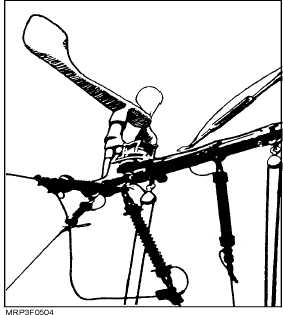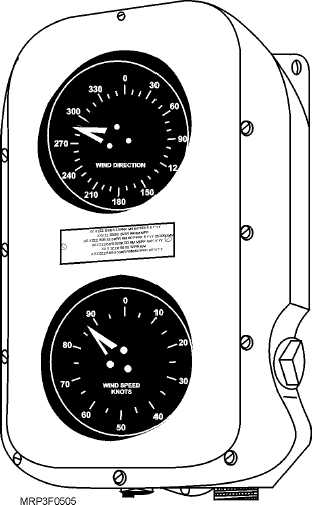5-16
Figure 5-4.—An installed anemometer.
Figure 5-5.—Synchro repeater showing relative wind velocity
and direction.
United States Storm Warning Signals.—The
combinations of flags and pennants, as shown in
figure 5-6, are hoisted at the National Weather Service
and other shore stations in the United States to indicate
the presence or future presence of unfavorable winds.
The means of the various displays are as follows:
Small craft warning: One red pennant displayed
by day and a red light over a white light at night to
indicate that winds up to 38 miles per hour (33 knots)
and/or sea conditions dangerous to small craft operations
are forecast for the area.
Gale warning: Two red pennants displayed by
day and a white light above a red light at night to
indicate that winds ranging from 39 to 54 miles per hour
(34 to 47 knots) are forecast for the area.
Storm warning: One square red flag with a black
center displayed during daytime and two vertical red
lights at night to indicate that winds 55 miles per hour
(48 knots) and above, no matter how high the speed, are
forecast for the area. If the winds are associated with a
tropical cyclone (hurricane), the storm-warning display
indicates that winds within the range of 55 to 73 miles
per hour (48 to 63 knots) are forecast.
Hurricane warning (displayed only in connection
with a tropical cyclone or hurricane): Two square red
flags with black centers displayed at daytime and a white
light between two vertical red lights at night to indicate
that winds 74 miles per hour (64 knots) and above are
forecast for the area.
Timely and accurate weather observations are basic
to the development of meteorological and oceanographic
forecasts in support of fleet operations. Since the U.S.
Navy may be committed to operations anywhere in the
world, total global observations of meteorological and
oceanographic conditions are required. Ships in port are
required to make regular weather observations and to
report by electronic means unless there is a nearby U.S.
manned weather-reporting activity. In-port weather
observations and reports of guard ship arrangements
may be used for groups of ships at the discretion of the
senior officer present. In such instances, the weather logs
of exempted ships should bear a notation of the guard
ship(s) and effective dates and times. Table 5-1 provides
the minimum requirements for reporting weather
observations by Navy ships.



